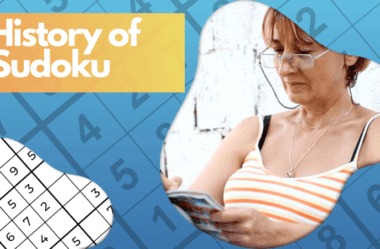Reading time: 6 minutes
Introduction
Ever found yourself deeply engrossed in a Sudoku puzzle game, feeling both challenged and entertained? Sudoku has an intriguing history that spans centuries, blending ancient numerical puzzles with modern brain teasers. Whether you’re solving a Sudoku book or playing an online Sudoku game, let’s dive into the origins and evolution of this captivating puzzle.
The Origins of the Sudoku Puzzle Game
Early Beginnings of Sudoku Puzzles
Long before Sudoku became a household name, ancient civilizations were already dabbling with numerical puzzles. The roots of Sudoku can be traced back to the Chinese Magic Square, an arrangement of numbers in a square grid where the sums of each row, column, and diagonal are equal. These early puzzles were not just games but held mystical and religious significance, often used in rituals and to symbolize harmony and balance.
Interestingly, similar numerical puzzles appeared in other ancient cultures. In India, the “Ramakien,” a version of the epic Ramayana, includes references to numerical puzzles. These early forms laid the groundwork for the structured and logical format we recognize in Sudoku today.
Learn more about Chinese Magic Squares
18th Century Contributions to Sudoku Puzzles
Fast forward to the 18th century, and we meet Leonhard Euler, a Swiss mathematician who introduced the concept of the Latin Square. Euler’s creation involved filling a grid with symbols in such a way that each symbol appears only once per row and column. While Euler’s work was primarily mathematical, it paved the way for modern puzzles by establishing principles of uniqueness and order.
Euler’s Latin Square was a significant leap in the evolution of numerical puzzles. Though not exactly Sudoku, it provided a crucial link between ancient numerical games and the logic-based puzzles that would follow.
Read more about Leonhard Euler and Latin Squares
The Birth of the Modern Sudoku Puzzle Game
Howard Garns and the Birth of Number Place
The modern Sudoku puzzle game, as we know it, was born in 1979 thanks to Howard Garns, an American architect and puzzle enthusiast. Garns created “Number Place,” a puzzle published in Dell Magazines that required players to fill a 9×9 grid with numbers 1 through 9, ensuring no repetition in any row, column, or 3×3 subgrid.
Garns’ innovation was relatively obscure until it crossed the Pacific. In 1984, it was introduced to Japan by Nikoli, a puzzle publishing company, and rebranded as “Sudoku,” which means “single number.” This rebranding and introduction to a puzzle-loving culture sparked the beginning of Sudoku’s global journey.
The Global Phenomenon
Sudoku’s true rise to fame came in the early 2000s when it was reintroduced to the Western world. British newspapers began publishing Sudoku puzzles, and their popularity exploded. Soon, Sudoku was a daily feature in newspapers worldwide, with millions of enthusiasts solving puzzles over breakfast.
The internet further amplified Sudoku’s reach. Online platforms and mobile apps made it possible for people to access an endless supply of Sudoku puzzles anytime, anywhere. This digital revolution not only sustained Sudoku’s popularity but also attracted a new generation of puzzlers.
Explore the history of Sudoku
Cognitive Benefits of Playing Sudoku Puzzle Games

Mental Benefits
Solving Sudoku puzzles is more than just a pastime; it’s a robust exercise for the brain. Engaging with Sudoku regularly can significantly boost cognitive skills such as logical thinking, problem-solving, and pattern recognition. These skills are crucial not only for puzzle-solving but for everyday decision-making and mental agility.
Scientific studies support these benefits. Research has shown that adults who engage in brain exercises like Sudoku tend to have sharper minds and slower cognitive decline as they age. Sudoku serves as a mental gym, keeping the brain fit and active.
Educational Uses
Sudoku’s educational value extends to the classroom, where it is used as a tool to enhance learning. Teachers incorporate Sudoku into lessons to help students develop logical reasoning and critical thinking skills. Unlike traditional rote learning, Sudoku encourages students to think independently and strategically.
For younger children, Sudoku can be a fun way to improve numerical literacy. By solving puzzles, children learn to recognize patterns and sequences, laying a solid foundation for advanced mathematical concepts. This early engagement with cognitive exercise games helps in cognitive development during critical formative years.
The Cultural Significance of Sudoku Puzzle Games
A Worldwide Puzzle
Sudoku’s appeal is truly global, transcending cultural and linguistic barriers. From Tokyo to New York, millions of people solve Sudoku puzzles daily, making it a universal pastime. This widespread popularity highlights Sudoku’s unique ability to bring people together through a shared love of puzzles.
Different cultures have also adapted Sudoku to their tastes. In Japan, for instance, variations like “Killer Sudoku” and “Jigsaw Sudoku” have gained popularity, offering even more challenges to enthusiasts. This adaptability has ensured Sudoku’s place in diverse cultural landscapes.
Community and Competitions
The Sudoku community is vibrant and enthusiastic, with numerous competitions held worldwide. The World Sudoku Championship, for example, attracts top solvers from around the globe, showcasing their skills in intense, timed rounds. These competitions not only highlight individual talent but also foster a sense of community among participants.
Beyond formal competitions, there are countless online forums and social media groups where Sudoku fans share tips, strategies, and puzzles. This global network of Sudoku enthusiasts keeps the community alive and thriving, continually pushing the boundaries of what can be achieved with a simple grid of numbers.

The Future of Sudoku Puzzle Games
The advent of technology has transformed Sudoku from a paper-and-pencil game into a digital phenomenon. Mobile apps and online platforms offer endless variations of Sudoku, from classic puzzles to innovative hybrids. These digital versions often come with features like hints, timers, and difficulty levels, making Sudoku accessible to both beginners and experts.
Artificial Intelligence (AI) has also made its mark on Sudoku. AI algorithms can generate and solve Sudoku puzzles in seconds, providing insights into puzzle design and solving techniques. This intersection of AI and Sudoku opens up new possibilities for creating even more challenging and engaging puzzles.
However, despite the convenience of digital platforms, many Sudoku enthusiasts still cherish the tactile experience of solving puzzles on paper. The physical act of writing numbers, erasing mistakes, and physically turning the page offers a unique satisfaction that technology cannot replicate. Playing Sudoku on paper enhances focus and minimizes digital distractions, allowing for a more immersive and meditative experience. The simplicity of a paper Sudoku book, free from screen glare and notifications, provides a delightful, analog pleasure that many find irreplaceable. This traditional approach also fosters a deeper connection with the puzzle, making each solved grid a small, yet meaningful, achievement.
Conclusion
Sudoku’s journey from ancient numerical puzzles to modern brain teasers is a testament to its enduring appeal and cognitive benefits. This rich history highlights Sudoku’s unique ability to entertain, educate, and challenge the mind. As we continue to embrace Sudoku in various forms, its role in promoting mental fitness and cognitive development remains invaluable.
Ready to boost your brainpower? Grab a Sudoku game book from MindBoost Books, share your Sudoku experiences in the comments, and explore our range of activity books designed to unlock your full potential. Happy puzzling!







Permalink